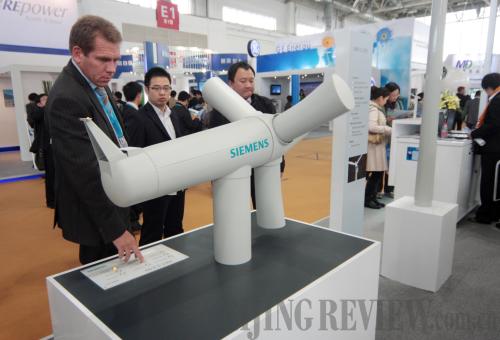|
 |
|
A STILL BREEZE: A visitor checks out Siemens wind power technology on display at an international wind power exhibition in Beijing on October 21 (CFP) |
The significance of developing new energy resources has been proven far beyond finding energy alternatives. It has become a strategic choice for all nations with which to ensure their energy security, while combating climate change.
At the 12th China-EU summit held in Nanjing at the end of November, leaders of both sides focused on coordinating positions for negotiations at the Copenhagen climate change conference, while discussing how the world economy could further recover, among other topics. New energy, meanwhile, was deemed as a key area of cooperation.
New energy refers to a variety of energy sources explored and utilized with new technologies, including wind power, solar energy, biomass, clean coal, coal bed gas, natural gas hydrates, nuclear energy and hydrogen energy.
Smart grid technology and carbon capture and storage are also industries closely related to new energy. Since the degree of harm these inflict on the environment is little or nonexistent, they are often referred to as clean energy or green energy.
A solution to climate change
The EU regards promoting climate change negotiations as an important manifestation of its international leadership. According to Danish Prime Minister Lars Loekke Rasmussen, the Copenhagen conference would strive for a politically binding declaration with specific commitments.
If this declaration is named after Copenhagen, and finally serves as the basis of the general agreement to be reached at the Mexico City climate change conference in 2010, it will be fantastic for Denmark, the EU and the whole world.
But given the uncertainty in U.S. legislation on greenhouse gas emissions reduction—coupled with the huge disputes among various nations—countries might not be able to come up with a specific emissions reduction target in the declaration.
Still, faced with the unprecedented and unanimous political appeal and public support worldwide, politicians of all countries must strive for substantial breakthroughs.
The key to any breakthrough, of course, will most likely rest with the utilization of energy—in particular, adopting new energy and improving energy efficiency.
Specific figures, meanwhile, will likely be presented by participating countries on the utilization of new energy to make for more persuasive arguments. And China-EU cooperation will inevitably prove a strong driving force for this breakthrough.
At the beginning of 2007, the EU unveiled a new energy policy proposal suggesting that by 2020 renewable energy should account for 20 percent of the EU's energy supply and total energy consumption should be cut by 20 percent.
To fulfill these goals, the EU passed a package plan aimed at distributing the responsibility for emissions reduction more equitably among its member states early last year.
When it comes to developing new forms of energy, the EU has always been ambitious with a strong ability to pursue its endeavors.
Leading to a declaration on new energy in Copenhagen will fully demonstrate its leadership, while winning advantages in the ensuing hard negotiations on technology transfers and financial support.
In China, the Central Government has already defined new energy as an important driving force behind economic growth.
The Mid- and Long-term Development Plan for Renewable Energy, for instance, proposed that renewable energy account for 10 percent of China's total energy consumption by 2010 and 15 percent by 2020. The upcoming new energy development plan, meanwhile, will set the goal of increasing the total installed capacity of wind power, photovoltaic (PV) power and nuclear power to 150 million kw, 20 million kw and 80 million kw by 2020—being five times, 11.11 times and twice as much as that of the current plan, respectively.
Given the explicit support of domestic policies, China and the EU will probably reach agreements on new energy and related technology transfers and financial support.
In addition, the United States, a key party in global climate change negotiations, passed the American Clean Energy Leadership Act this June. The act states that 15 percent of the power in the United States shall be generated by renewable energy sources by 2020.
The American Recovery and Reinvestment Act of 2009 provides $42 billion toward government projects and $2 billion worth of tax incentives to be used toward projects promoting renewable energy and energy efficiency.
These acts have made it possible for the Obama administration to make promises on new energy issues. So long as China and the EU coordinate well and use their influences over the United States at correct moments, there is a great likelihood that a political declaration with substantial breakthroughs will be passed at the Copenhagen conference.
| 